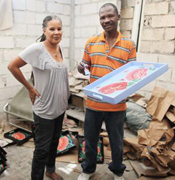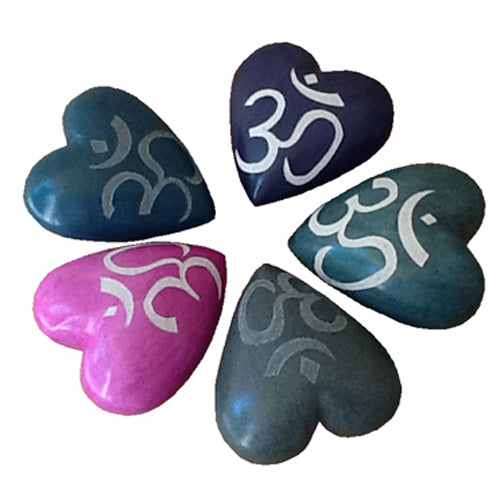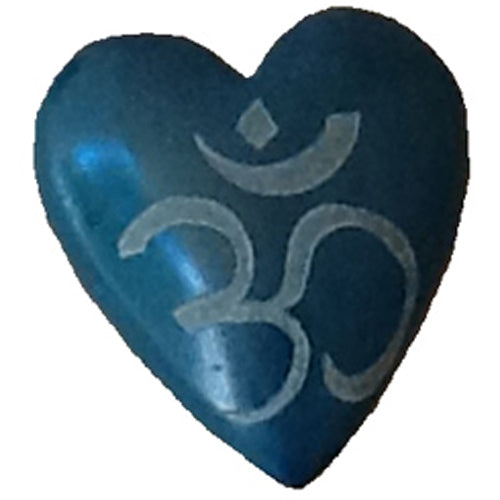OWP
Corazón de esteatita con símbolo Om grabado
Corazón de esteatita con símbolo Om grabado
No se pudo cargar la disponibilidad de retiro
OM es un sonido sagrado y un ícono espiritual en las religiones indias. También es un mantra en el hinduismo, el budismo, el jainismo y el sijismo.
La piedra se encuentra en tierras de Haití. Se remoja en agua para que sea más fácil de manipular. Luego se martilla, cincela y lima para obtener las líneas correctas. Este proceso podría llevar horas dependiendo de la pieza que estén creando. Luego lijan y pulen para conseguir un brillo suave en las piezas.
- Medidas de los corazones: 1-1/2'' de alto x 3'' de ancho x 3-1/4'' de profundidad
- Opciones de colores: verde, verde azulado, rosa, gris y morado.
- El tamaño y el color pueden variar.
Hecho a mano en Haití e importado de comercio justo.
 A menudo se considera a Haití como la nación más pobre del hemisferio occidental. Los artesanos haitianos viven en un país donde el clima político y las dificultades impuestas por los embargos y sanciones económicas en los años 1990 han contribuido a la pobreza y han acelerado la degradación ambiental. La atención sanitaria y la educación son sueños inalcanzables para la mayoría empobrecida del 75-80%. El ingreso promedio es de $55. por mes. Sólo el 40% de la población tiene acceso a agua potable y el 25% tiene acceso a sistemas de alcantarillado sanitario. La mortalidad infantil supera el 7%, la desnutrición es una dolencia común y casi la mitad de la población es analfabeta.
A menudo se considera a Haití como la nación más pobre del hemisferio occidental. Los artesanos haitianos viven en un país donde el clima político y las dificultades impuestas por los embargos y sanciones económicas en los años 1990 han contribuido a la pobreza y han acelerado la degradación ambiental. La atención sanitaria y la educación son sueños inalcanzables para la mayoría empobrecida del 75-80%. El ingreso promedio es de $55. por mes. Sólo el 40% de la población tiene acceso a agua potable y el 25% tiene acceso a sistemas de alcantarillado sanitario. La mortalidad infantil supera el 7%, la desnutrición es una dolencia común y casi la mitad de la población es analfabeta.
A pesar de esta adversidad hay esperanza. Artisan Business Network (ABN) brinda a los haitianos herramientas empresariales, aportes de diseño y acceso al mercado. La ABN está logrando mejoras esenciales en los ingresos de los artesanos, ayudándolos a mantener a sus familias y el bienestar de la comunidad a través del comercio basado en la profunda cultura artesanal de Haití.
ABN se esfuerza por potenciar la cultura artesanal de Haití para mejorar el bienestar de la comunidad. Tienen tres depósitos ubicados en Jacmel, Puerto Príncipe y Croix-des-Bouquets y apoyan las artes tradicionales en varios medios, entre ellos: artesanía en metal, esteatita, papel maché y fibras vegetales.
Los haitianos talentosos están listos y ansiosos por recuperar las pérdidas provocadas por el embargo comercial económico de la década de 1990, el posterior estancamiento político interno y la devastación del terremoto de enero de 2010. Gracias a los esfuerzos de ABN y su capacidad para conectar las artesanías con el mercado internacional, muchos artesanos ahora pueden cuidar mejor de sí mismos y de sus familias.
Share
About the Artisans
About the Artisans
 Joyeria Semilla meaning Seed Jewelry is a small fair-trade workshop in the Andean town of Villa de Leyva, Colombia. Girasol Taborda, a local artisan and social entrepreneur, started the workshop in the mid-1990s.
Joyeria Semilla meaning Seed Jewelry is a small fair-trade workshop in the Andean town of Villa de Leyva, Colombia. Girasol Taborda, a local artisan and social entrepreneur, started the workshop in the mid-1990s.
Joyeria Semilla’s objective is three-folds; to create new jobs, revive Colombia's handicrafts sector and to motivate locals to better manage their natural resources. The organization works primarily with socially and economically disadvantaged youths, single mothers and people with disabilities in the area. The company offers free training in product design, technical training and marketing to new members. Joyeria Semilla has trained them in the craft of jewelry-making.

Caña Flecha or “Gynerium Sagittatum” is a locally found palm tree in the regions of the Caribbean coast. The leaves from this plant are used for making jewelry, woven hats, bags and baskets. The Zenú Indians were and their descendants inherited the tradition of picking veins of the green palm leaf for weaving. These veins were made into woven hats and other products for their personal use.
The Zenú culture is said to have existed between 200BC to1600AD. With the arrival of the colonizers in the 16th century, the indigenous community declined of unknown reasons. Today a very small population remains that claims the inheritance of the almost extinct Zenú tribe. Known for their skills in the construction of major waterworks, canals and irrigation system along with being skilled goldsmiths, examples of their accomplished craftsmanship are found in various museums around the world. Their larger means of subsistence were hunting, farming, fishing and trading.
Caña Flecha is found in abundance in the region, and hence makes for a sustainable and naturally available raw material for these products. Every bit of the plant is utilized – from using in building walls and roofs in houses to food for cattle and medicinal purposes. It is from the central vein of the leaf that the fibers for weaving are obtained. After the hard surface is peeled off, the fibers are left in the sun to dry and undergo a natural tinting process; these fibers are barely about 1 millimeter in thickness and hence call for a lot of skill and patience to weave with. The dried fibers are then processed for natural coloration - some are boiled with lemon to whiten them and some are treated with mud and boiled with plantain leaves to blacken them. The designs are based on ancient motifs and mathematical representations, which are inspired by the early Zenú culture.










